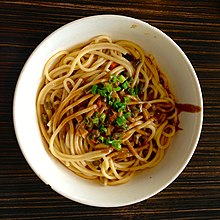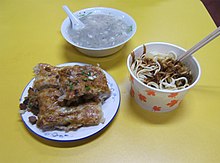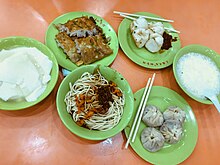Hot dry noodles
This article needs additional citations for verification. (January 2009) |
 | |
| Alternative names | 热干面 |
|---|---|
| Type | Noodles |
| Course | Breakfast |
| Place of origin | China |
| Region or state | Wuhan |
| Main ingredients | Alkaline noodles, soy sauce, sesame paste, pickled carrots, garlic, Chive oil |


Hot dry noodles (simplified Chinese: 热干面; traditional Chinese: 熱乾麵; pinyin: règānmiàn), known in Chinese as reganmian,[1] is a traditional dish of Wuhan, the capital of Hubei province in central China.[2] Hot dry noodles have an 80-year history in Chinese food culture; they are unique because the noodles are not in a broth like most other Asian-style hot noodle dishes.[3] They are the most significant, famous and popular breakfast food in Wuhan, often sold by street carts and restaurants in residential and business areas.[4] The price is between 4-6 yuan. Breakfasts such as hot dry noodles are available from about 5 am, These noodles can be prepared within minutes and are affordable, so they are a popular breakfast. There are hot dry noodle restaurants all over the city.
Typical hot dry noodle dishes contain soy sauce, sesame paste, pickled vegetables (carrots and beans), chopped garlic chives and chili oil.[5] Hot dry noodles, along with Shanxi's knife-cut noodles (刀削面; 刀削麵; dāoxiāomiàn), Liangguang's yifumian, Sichuan's dandanmian, and northern China's zhajiangmian, are collectively referred to as the "top five noodles of China" by People's Daily, and in a 2013 article titled "China's Top 10 famous noodles" Business Insider reported that CNTV rated hot dry noodles the top Chinese noodle dish.[6][7] The specifics of the preparation of hot dry noodles is discussed in Wuhan author Chi Li's novel Cold or Hot, It's Good to Live (冷也好热也好活着就好).
The recipe for hot dry noodles differs from cold noodles and soup noodles, as the dish is served hot without broth.
The fresh noodles are mixed with sesame oil and cooked in boiling water. The cooked and cooled noodles become pliable. Before eating, the noodles will be cooked again the same way, and dressings including spring onion and sauce are added.[9] While preparing hot dry noodles, the noodles are placed into a cone-shaped strainer, dipped briefly into boiling water, and then swirled and drained. The noodles are poured into a paper bowl, sesame paste, salt, pepper, sugar, vinegar, soy sauce, chive and pickled radish are added, poured on top and stirred.
Noodles Preparation
The noodles need to be prepared at first. In order to make the noodles tender, alkali powder is the key ingredietnt. Put alkali powder into water before the day of making noodles. After that, mix the alkali powder and some salt with flour in a ratio of 2:1:250. Knead and split the dough into noodles. During the process, making sure that the diameter of each noodle between 1.5 and 1.6 mm which would gain better flavor when boiling.
Then, dredging the noodles with a large pot and high heat. Put the raw noodles in the pot before the water is boiled. Repeat the procedure of stiring up with chopsticks which prevent noodles form into clumps. Also repeat the process of adding cold water after boil and lid up until boiling. After noodles become transparent, take out the noodles and put it into colander to drain the water in the noodles. After draining, quickly place the noodles into a bowl. Add prepared sauce directly into it and add some spring onions. Then it is done.
Sauce Preparation
The sauce need to be prepared at the firsthand. Mix soy sauce, balsamic vinegar, pepper, MSG, sesame paste, sesame oil, red and white carrot cubes, Chinese chives in the proportion of 20:8:1:1:15:18:5:4:5. Also add sugar in the soy sauce in a proportion of 1:50.[10]
Origin
[edit]Summer in Wuhan is extremely long, and the high temperature causes food to deteriorate rapidly. Consequently, in the past people added dietary alkali into noodles to slow deterioration; this evolved into Hot Dry Noodles.
There is no certain script that clarifies the inventor of hot dry noodles. Here are the versions of the creators of hot dry noodles:
Bao Li
[edit]
According to a widely circulated version of the origin story, in the 1930s, there was a small food stand on Changdi Street operated by Bao Li, a hawker who made a living by selling bean noodles and noodle soups in the Guandi temple area in Hankou. Due to the hot weather, business was bad and many noodles were not sold. There were no refrigerators at that time. If these noodles were sold the next day, they would definitely go bad and be inedible. What to do? Li Bao was very worried. Suddenly, Li poured sesame oil onto his noodles accidentally; he boiled them and added shallot and other condiments the next day, and sold them the next morning. His noodles became very popular because of their unique taste, and customers asked Bao Li what kind of noodle it was; Bao Li answered "hot dry noodles".[11]
From then on, Bao Li specialized in hot dry noodles, which caused a sensation in Wuhan with many customers. Many cooks learned from him and specialized in making hot dry noodles. However, most people considered Bao Li as the inventor of the way of making such noodles. His version of hot dry noodles has huge difference compared to the hot dry noodles nowadays.
Cai Mingwei
[edit]Cai Mingwei was born in April 1912 in Caijiazha Street, Huangpi District. He worked in a Pharmacy in Hankou for 6 years. After leaving the Pharmacy, he started to sell noodles. This kind of noodles is made by boiling traditional oil noodles, taking them out, pouring sesame oil on them and mixing them together. Many people in Hankou make a living from this, especially the people from Huangpi. Cai Mingwei chose to do business for students at the school gate. In the process of selling noodles, he gradually improved the taste of noodles. In order to make noodles quickly in the morning, he cooked the noodles to 80% done in advance, poured water to cool them down, added oil to mix them, spread them out to cool and dry them, and rolled them into a bunch for use. When buying noodles, boil them in boiling water, remove the core and add seasonings, and they can be eaten, which increases the speed. Later, in order to increase the toughness of machine-made noodles, he absorbed the practice of oil noodles and gradually added salt and edible alkali. His work experience as a pharmacy clerk made him realize the role of sesame oil, so he tried to add sesame paste without decanting oil to noodles, and sprinkled sesame oil, balsamic vinegar and other homemade special seasonings on it to form sesame paste noodles. Later, Cai Mingwei also cut the carrots from his hometown in Huangpi into strips, marinated them with salt, soy sauce, five-spice powder, etc., and dried them slightly after draining them. Finally, he added pure sesame paste, pepper powder, and granulated sugar, and finally formed the hot dry noodles that Wuhan people eat now.
Hot dry noodles were officially named in 1950. In 1945, after the victory of the Second Sino-Japanese War, Cai Mingwei opened the famous hot dry noodles restaurant Cai Lin Ji at the corner of Manchun Road, Zhongshan Avenue. According to legend, the name of Cai Lin Ji came from two tall Chinaberries in front of the store. Some people say that the two trees, firstly, symbolize your hard work and happiness, secondly, Cai Mingwei has two sons, so good things come in pairs, and naming the store Cai Lin Ji will bring good luck.[12][13][14][15]
Cultural Significance
[edit]Hot dry noodles is not only a delicacy, but also a symbol of culture. It carries the memory and emotions of Wuhan people and is an indispensable part of their lives.
Geographical environment and climate
Talking about hot dry noodles's significance, the local climate plays an important role in such cuisine.

Wuhan has a subtropical monsoon climate in the central part of the city, with abundant rainfall and sunshine. There are many water bodies, and the entire city is divided into three parts the Yangtze River and the Han River. There are also large and small lakes including the East Lake, and the terrain is mainly plains. Under such climatic conditions, it is difficult for local heat to dissipate in the summer, resulting in hot and humid weather.[16]Food is hard to stay fresh in such circumstances. However, the noodles of hot dry noodles are processed with alkaline water (baking soda + water) which has low water content and is more durable than ordinary noodles. The ingredients of the sauce are also easily stored and hard to get bad. The quality of noodles and sauce allows hot dry noodles to be made by families and restaurants at any time. In winter, due to the lack of terrain barriers, it is easily affected by cold air from the north, the humidity is high and the cold is biting. The weather is cold in the winter. But the noodles of hot dry noodles are dry, durable, and not affected by moisture since they absorb the alkaline water
The climate and environment will also change the appetite of people in Wuhan. In summer, a hot and humid environment makes people feel tired and have poor appetites. But hot dry noodles, due to the sesame paste and vinegar, have a strong taste which could quickly arouse appetite. [17]In winter, people need high-calorie food to keep warm. Sesame paste is high in fat and the noodles are high in carbohydrates which could help people to replenish energy.
Humanities

Eating breakfast in Wuhan is commonly known as "Guozao" which means the special bond between people in Wuhan and the breakfast. In the 20th century, ships often passed by the docks in Wuhan, and boatmen, dock workers, and merchants from all over the country gathered here.[18] In such a crowded and mobile area, people also demanded simple and fast food, so hot dry noodles became the first choice. Nowadays, people in Wuhan are accustomed to getting up early to go to work or do morning practice. Hot dry noodles are still the top choice for breakfast. Besides that, people in Wuhan have the habit of eating food while walking. The convenience of hot dry noodles makes such a common habit more common.
Variety
[edit]During the development and spread of the technique of making hot dry noodles, people in Xinyang, a city in Henan Province, developed their own special way to make them, which became a variant of hot dry noodles eventually.[19]
The difference on hot dry noodle between Wuhan and xinyang is quantity,xinyang hot dry noodle generally use a larger bowl than Wuhan. And Wuhan hot dry noodles are usually eaten in the morning. In Wuhan, they usually cook the noodles in water first and then add the sauce, but xinyang uses beef and minced beef,and then add meat soup. In contrast, Xinyang hot dry noodles have a more mellow flavor. In terms of seasoning, Wuhan hot dry noodles use a higher percentage of peanuts in sesame sauce, but Xinyang is more of a sesame sauce flavor.
Region
[edit]China
Small restaurants serving Wuhan's hot dry noodles, which have been a staple of the local population for hundreds of years, are located throughout China and serve a variety of inexpensive dishes, with egg drop soups as well as wonton stews to choose from. Hot noodles can be served with beef or lamb, making it a dish for all seasons.
Japan
There's a restaurant in Ginza, Tokyo, Japan that has relatively authentic hot dry noodles for 19 RMB, but interestingly enough, it uses noodles that have been prepared with black sesame seeds and filled with crushed peanuts.
United states
In Flushing, New York, where there is a Chinese hot dry noodle store, Wuhan people there have a sense of home, which is also the only authentic hot dry noodle store, and priced at 30-40 yuan.
See also
[edit]References
[edit]- ^ Dong, M.Y.; Goldstein, J.; Goldstein, J.L. (2006). Everyday Modernity in China (Studies in Modernity and National Identity; A China Program Book). A China program book. University of Washington Press. p. 36. ISBN 978-0-295-98602-9.
- ^ OotTheMonk. (2012, Feb 20). [Web log message]. Retrieved from https://www.instructables.com/id/Hot-and-Dry-Noodles-Re-Gan-Mian-/
- ^ Hubei Tourism Bureau. (2012, 04 21). Hot dry noodles . Retrieved from "Hot Dry Noodles". Archived from the original on 2012-07-22. Retrieved 2012-11-22.
- ^ Yu , J. F. (2006, 10 13). [Web log message]. Retrieved from https://wuhanstories.blogspot.ca/2006/10/needless-to-say-hot-dry-noodle-is-most.html
- ^ Hot dry noodles. (2004, 09 03). Retrieved from Hot Dry Noodles
- ^ ""中国十大面条"出炉热干面居首 你吃过几样". 人民网. Archived from the original on 2014-01-17. Retrieved 2013-07-09.
- ^ "IT'S OFFICIAL: Here Are The Top 10 Kinds Of Chinese Noodles". Business Insider. Retrieved July 9, 2013.
- ^ "武汉"蔡林记热干面"视频蹿红_武汉24小时_新闻中心_长江网_cjn.cn". news.cjn.cn. Retrieved 2024-11-17.
- ^ Xu, X. (2008). Re gan mian (hot-dry noodles). Retrieved from "Re Gan Mian (Hot-dry Noodles)". Archived from the original on 2012-11-13. Retrieved 2012-11-23.
- ^ "蔡林记的配方_百度知道". zhidao.baidu.com. Retrieved 2024-11-17.
- ^ 不详. "热干面的起源故事". 炎黄风俗网.
- ^ "武汉热干面是谁发明的?_百度知道". zhidao.baidu.com. Retrieved 2024-11-17.
- ^ wuhanews. "武汉的热干面的来源 热干面的由来的故事". 武汉热线 (in Chinese (China)). Retrieved 2021-04-28.
- ^ Anderson, E. N. (1990/09/10). The food of china. (1st ed.). Yale University Press. Retrieved from "Food Culture - Kaleidoscope". Archived from the original on 2012-12-12. Retrieved 2012-11-22.
- ^ 湘水散人. (2009, 09 03). Hot dry noodles [Online forum comment]. Retrieved from https://www.3us.com/thread-3991-1-1.html
- ^ "Wuhan climate: weather by month, temperature, rain - Climates to Travel". www.climatestotravel.com. Retrieved 2024-11-19.
- ^ "武汉美食之热干面 | www.wenxuecity.com". www.wenxuecity.com. Retrieved 2024-11-19.
- ^ "百度安全验证". wappass.baidu.com. Retrieved 2024-11-19.
- ^ "Xinyang Hot Dry Noodles". henan.sina.com.cn. 2013-01-11. Archived from the original on 2017-03-21.
